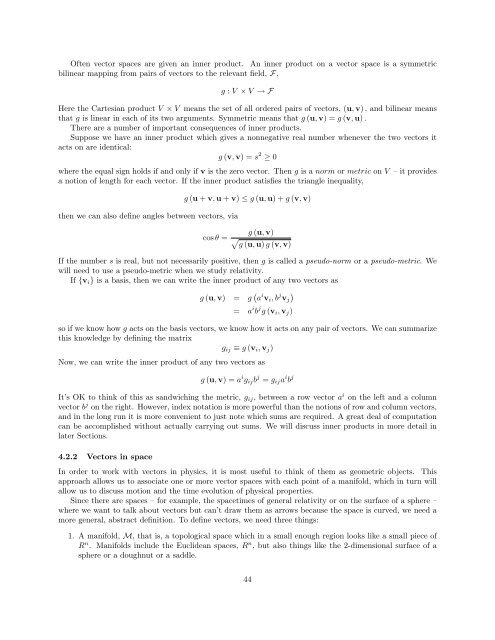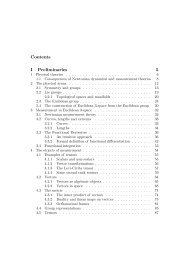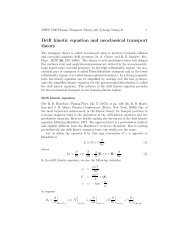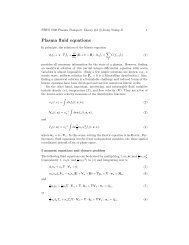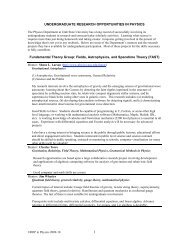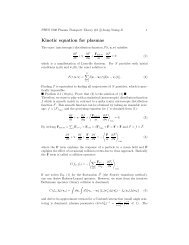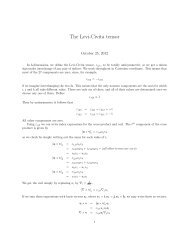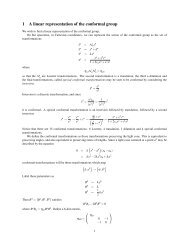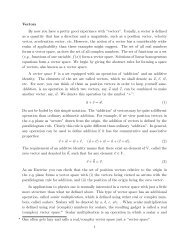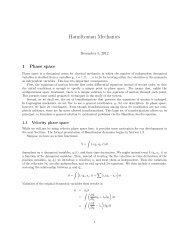Wheeler, Mechanics
Wheeler, Mechanics
Wheeler, Mechanics
Create successful ePaper yourself
Turn your PDF publications into a flip-book with our unique Google optimized e-Paper software.
Often vector spaces are given an inner product. An inner product on a vector space is a symmetric<br />
bilinear mapping from pairs of vectors to the relevant field, F,<br />
g : V × V → F<br />
Here the Cartesian product V × V means the set of all ordered pairs of vectors, (u, v) , and bilinear means<br />
that g is linear in each of its two arguments. Symmetric means that g (u, v) = g (v, u) .<br />
There are a number of important consequences of inner products.<br />
Suppose we have an inner product which gives a nonnegative real number whenever the two vectors it<br />
acts on are identical:<br />
g (v, v) = s 2 ≥ 0<br />
where the equal sign holds if and only if v is the zero vector. Then g is a norm or metric on V – it provides<br />
a notion of length for each vector. If the inner product satisfies the triangle inequality,<br />
then we can also define angles between vectors, via<br />
g (u + v, u + v) ≤ g (u, u) + g (v, v)<br />
cos θ =<br />
g (u, v)<br />
√<br />
g (u, u) g (v, v)<br />
If the number s is real, but not necessarily positive, then g is called a pseudo-norm or a pseudo-metric. We<br />
will need to use a pseudo-metric when we study relativity.<br />
If {v i } is a basis, then we can write the inner product of any two vectors as<br />
g (u, v) = g ( a i v i , b j v j<br />
)<br />
= a i b j g (v i , v j )<br />
so if we know how g acts on the basis vectors, we know how it acts on any pair of vectors. We can summarize<br />
this knowledge by defining the matrix<br />
g ij ≡ g (v i , v j )<br />
Now, we can write the inner product of any two vectors as<br />
g (u, v) = a i g ij b j = g ij a i b j<br />
It’s OK to think of this as sandwiching the metric, g ij , between a row vector a i on the left and a column<br />
vector b j on the right. However, index notation is more powerful than the notions of row and column vectors,<br />
and in the long run it is more convenient to just note which sums are required. A great deal of computation<br />
can be accomplished without actually carrying out sums. We will discuss inner products in more detail in<br />
later Sections.<br />
4.2.2 Vectors in space<br />
In order to work with vectors in physics, it is most useful to think of them as geometric objects. This<br />
approach allows us to associate one or more vector spaces with each point of a manifold, which in turn will<br />
allow us to discuss motion and the time evolution of physical properties.<br />
Since there are spaces – for example, the spacetimes of general relativity or on the surface of a sphere –<br />
where we want to talk about vectors but can’t draw them as arrows because the space is curved, we need a<br />
more general, abstract definition. To define vectors, we need three things:<br />
1. A manifold, M, that is, a topological space which in a small enough region looks like a small piece of<br />
R n . Manifolds include the Euclidean spaces, R n , but also things like the 2-dimensional surface of a<br />
sphere or a doughnut or a saddle.<br />
44


